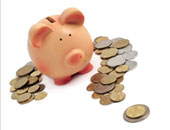Our modern economic system in the United States is established on debt. The economy does well when people borrow money they do not have and spend it on things they do not need. The reality is that if every consumer in America were to adopt a financially-responsible and frugal lifestyle, the American economy would most likely slip into another Great Depression.
The sad truth is that everywhere you turn in our modern culture, a person is bombarded with marketing and advertisements aimed at bilking people out of their hard-earned cash.
The average 25 year old American is already buried in debt. We encourage people to take on huge college debts, students typically tally up a few thousand dollars of credit card debt while in school, then that credit card debt tends to increase during the first few years after college, then a person takes on an auto loan, and within a few more years the biggest one of all comes—the mortgage.
The great news is that no matter how deep your debt is, it is possible to escape. There are rare cases where bankruptcy may be a viable alternative, but, most of the time, with a little hard work and persistence, you can escape the debt cycle, erase your debt, and take significant steps toward financial freedom.
The Choice
The first step toward true financial freedom is to really want it. This may sound basic and esoteric, but the truth is that this path is not easy. It will require sacrifices and living a frugal lifestyle. At times, this style of living will be contrary to what you want to do, and the only way a person will typically stay the path is if they truly desire financial freedom and victory over their finances.
Practical Steps
The second step is to stop incurring debt! No more credit card purchases, no more short term personal loans, do not apply for a business loan, etc. It is logically impossible to erase your debt over a period of time if you are consistently incurring more of it.
The third step is to conduct an objective evaluation of your spending habits. For 30 days, track every single expense and purchase that you make. Keep all of your receipts and write down every purchase in a notebook or keep track of it in an Excel spreadsheet. At the end of the 30 days, take your bank account statements, your receipts, and the notebook/spreadsheet and take a seat at the kitchen table or your desk.
The fourth step is to categorize your purchases and expenses. Make 2 lists on a piece of paper—“Essential” and “Non-Essential.” Now, assign each of your purchases to one of these two categories. Essential expenses are things like mortgage, auto loan, utilities, etc. No matter how essential you think the Lifetime channel is, do not place cable television in the “Essential” category!
After you are finished with assigning each expense, the fifth step is to look at all the expenses in the “Non-Essential” section. Your ability to erase your debt and reach true financial freedom will be based on your ability to remove as many items as possible from that list. Then, with all of that extra cash flow each month, you simply pay down a larger percentage of your debt. Pay as much as you possibly can every month. At times, if you apply for a business loan it can make sense if there is real potential for greater revenue in the future, but do all possible to incur no more debt.
It depends on each individual, but oftentimes small lifestyle adjustments can help take years off of a loan. For example, if you cut out cigarettes, soda, lottery tickets, and other inexpensive, but consistent non-essential purchases, that extra cash flow can be quite a substantial figure by the end of the year.
Remember, frugality is not about living cheap or living a monastic life! Be willing to make significant sacrifices, but always find the balance. There is no need to stop renting an apartment and move back in with your parents if you are 45 years old!
